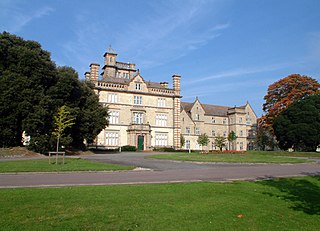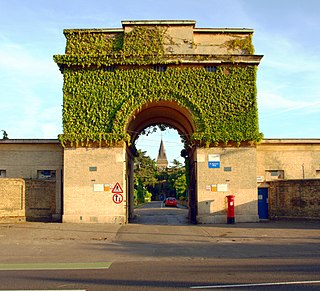
Blacktown Hospital is a university teaching hospital in Blacktown, New South Wales, Australia, about 34 kilometres from the Sydney CBD. Together with Mount Druitt Hospital and associated community health centres, it is a part of the Western Sydney Local Health District (WSLHD). The hospital is located in one of the fastest population growth areas in NSW, caring for patients from highly diverse cultural and social-economic status backgrounds.
Aradale Mental Hospital was an Australian psychiatric hospital, located in Ararat, a rural city in south-west Victoria, Australia. Originally known as Ararat Lunatic Asylum, Aradale and its two sister asylums at Kew and Beechworth were commissioned to accommodate the growing number of 'lunatics' in the colony of Victoria. Construction began in 1864, and the guardhouses are listed as being built in 1866 though the list of patients extends as far back as the year before (1865). It was closed as an asylum in 1998 and in 2001 became a campus of the Melbourne Polytechnic administered Melbourne Polytechnic's Ararat Training Centre.

Fulbourn Hospital is a mental health facility located between the Cambridgeshire village of Fulbourn and the Cambridge city boundary at Cherry Hinton, about 5 miles (8 km) south-east of the city centre. It is managed by the Cambridgeshire and Peterborough NHS Foundation Trust. The Ida Darwin Hospital site is situated behind Fulbourn Hospital. It is run and managed by the same trust, with both hospitals sharing the same facilities and staff pool.

The Fremantle Arts Centre is a historic building complex on Ord Street in Fremantle, Western Australia.

The Callan Park Hospital for the Insane (1878–1914) is a heritage-listed former insane asylum, which was subsequently, for a time, used as a college campus, located in the grounds of Callan Park, an area on the shores of Iron Cove in Lilyfield, a suburb of Sydney, New South Wales, Australia. In 1915, the facility was renamed as the Callan Park Mental Hospital and, again in 1976, to Callan Park Hospital. Since 1994, the facility has been formally known as Rozelle Hospital. In April 2008, all Rozelle Hospital services and patients were transferred to Concord Hospital. The Callan Park Act, 2002 (NSW) restricts future uses of the site to health, tertiary education and community uses.

St Bernard's Hospital, also known as Hanwell Insane Asylum and the Hanwell Pauper and Lunatic Asylum, was an asylum built for the pauper insane, opening as the First Middlesex County Asylum in 1831. Some of the original buildings are now part of the headquarters for the West London Mental Health NHS Trust (WLMHT).

The Parramatta Female Factory, is a National Heritage Listed place and has three original sandstone buildings and the sandstone gaol walls. The Parramatta Female Factory was designed by convict architect Francis Greenway in 1818 and the only female building authorized by Governor Lachlan Macquarie. It comprises the 1821 Matron's Quarters and Administration and Stores Building, the 1821 Female Hospital and the 1826 3rd Class Female Penitentiary. It is the first female factory in the penal colony of New South Wales, and is located at 5 Fleet Street, North Parramatta, New South Wales, Australia. It was one of 13 female factories in the colonies of New South Wales and Van Diemen's Land. In New South Wales, female factories were also established in Bathurst, Newcastle, Port Macquarie and Moreton Bay. The factory idea was a combination of the functions of the British bridewells, prisons and workhouses. The Parramatta Female Factory is being considered for World Heritage listing.

Sunnyside Royal Hospital was a psychiatric hospital located in Hillside, north of Montrose, Scotland. It closed in 2011 and is now used for housing.

Kew Lunatic Asylum is a decommissioned heritage-listed psychiatric hospital located between Princess Street and Yarra Boulevard in Kew, a suburb of Melbourne, Australia. Operational from 1871 to 1988, Kew Asylum was one of the largest asylums ever built in Australia. Later known as Willsmere, the complex of buildings were constructed between 1864 and 1872 to the design of architects G.W. Vivian and Frederick Kawerau of the Victorian Public Works Office to house the growing number of "lunatics", "inebriates", and "idiots" in the Colony of Victoria.
Royal Park Psychiatric Hospital, commonly known as Royal Park is a former Receiving House and Psychiatric Hospital located in Parkville. Operating for over 90 years, Royal Park Hospital was the first psychiatric hospital established in Victoria after the Lunacy Act of 1903, and was intended for patients with curable disorders. Built on the north-western edge of the 181 hectare parklands known as Royal Park, Royal Park Hospital along with Royal Melbourne Hospital, Royal Children's Hospital and Mount Royal formed the Parkville Hospital Precinct. Following the hospital's closure in the 1990s, several of the hospital's original buildings have been listed on the Victorian Heritage Register for their historic and architectural values.

St Nicholas Hospital is an NHS psychiatric hospital located in Gosforth, Newcastle upon Tyne, England, UK. The entrance is located on Jubilee Road. The buildings range from Victorian-era to modern facilities and occupy 12 hectares of land. The hospital is managed by Cumbria, Northumberland, Tyne and Wear NHS Foundation Trust.

The Gladesville Mental Hospital, formerly known as the Tarban Creek Lunatic Asylum, was a psychiatric hospital established in 1838 in the Sydney suburb of Gladesville. The hospital officially closed in 1993, with the last inpatient services ceasing in 1997.

St. Brendan's Hospital was a psychiatric facility located in the north Dublin suburb of Grangegorman. It formed part of the mental health services of Dublin North East with its catchment area being North West Dublin. It is now the site of a modern mental health facility known as the "Phoenix Care Centre". Since the official opening of the Richmond Lunatic Asylum in 1815 the Grangegorman site has continuously provided institutional facilities for the reception of the mentally ill until the present day. As such the Phoenix Care Centre represents the continuation of the oldest public psychiatric facility in Ireland.

Carrington Hospital is a former lunatic asylum and psychiatric hospital listed as a Category I by Heritage New Zealand located in Point Chevalier, Auckland.

Swanbourne Hospital is a heritage listed former mental hospital located in Mount Claremont, Western Australia. Built in 1904, it was the largest stand-alone psychiatric hospital in Western Australia for much of the twentieth century until its closure in September 1972. The hospital was originally known as Claremont Hospital for the Insane, Claremont Mental Hospital and Claremont Hospital. Following the closure of Claremont Hospital in 1972, the original 1904 section of the hospital functioned as the Swanbourne Hospital until 1985. The site was vacant from 1986, until renovated and reopened primarily as an aged care residence in 2018.
William Cresswell, was an inmate of the Parramatta Lunatic Asylum, in New South Wales who was considered as a claimant in the Tichborne case.
Glenside Hospital, as it was known from 1967, previously the Public Colonial Lunatic Asylum of South Australia, Parkside Lunatic Asylum and Parkside Mental Hospital, was a complex of buildings used as a psychiatric hospital in Glenside, South Australia.

The Parramatta Female Factory and Institutions Precinct is a heritage-listed conservation site in Parramatta, in the City of Parramatta local government area of New South Wales, Australia. The site was used as the historically significant Parramatta Female Factory from 1821 to 1848. After its closure, the main factory buildings became the basis for the Parramatta Lunatic Asylum, while another section of the site was used for a series of other significant institutions: the Roman Catholic Orphan School (1841–1886), the Parramatta Girls Home (1887–1974), the "Kamballa" and "Taldree" welfare institutions (1974–1980), and the Norma Parker Centre (1980–2008).

Newcastle Government House is a heritage-listed former military post and official residence and now park and psychiatric hospital at 72 Watt Street, Newcastle, New South Wales, Australia. It is also known as Newcastle Government House and Domain, Newcastle Military Barracks & Hospital, Newcastle Industrial School for Girls, Reformatory for Girls, Lunatic Asylum for Imbeciles, James Fletcher Hospital and Fletcher Park. It was added to the New South Wales State Heritage Register on 22 March 2011.














